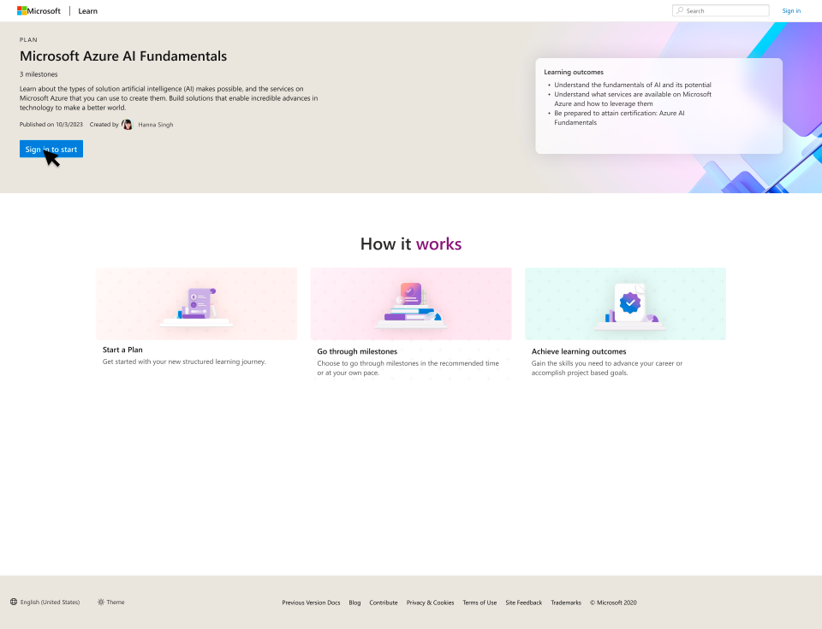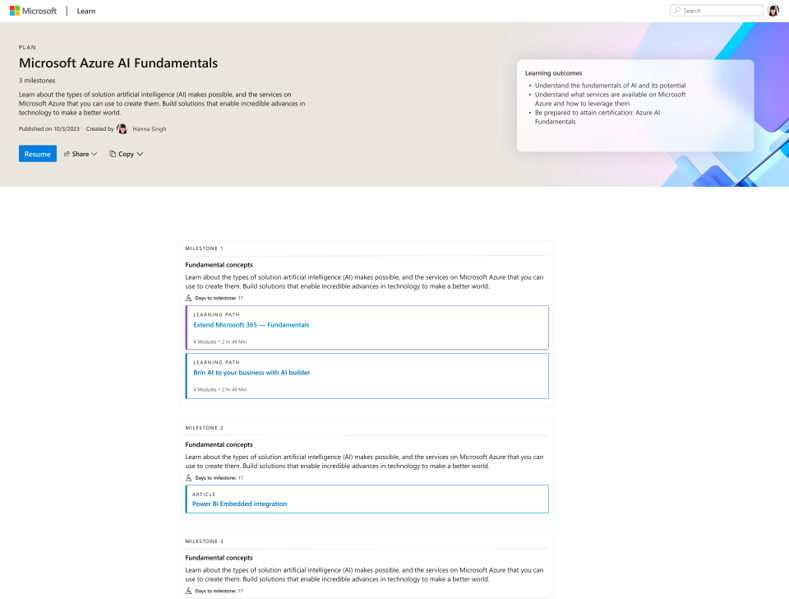Note
Access to this page requires authorization. You can try signing in or changing directories.
Access to this page requires authorization. You can try changing directories.
A Plan is a set of organized content on Microsoft Learn with milestones and optional email nudges designed to efficiently lead a learner to specific learning outcomes. Content in Plans covers all content types on Learn. Anyone can create a Plan and invite individual learners or groups of learners to a Plan and track their progress through reporting (summary of learners and a detailed report available to download). Anyone can start and complete a Plan on Learn as a learner.
View of the start page of a Plan from a learner's point of view

View of the Plan details from a learner's point of view

Use cases
For creators
- Create comprehensive curriculum leading to specific learning outcomes for employees, students, or any learning audience.
- Create project-based curriculums that lead learners to gain skills necessary for the tasks at hand.
For learners
- Start and complete Plans that you're invited to by your employer or educator.
- Start and complete Plans on Learn that have learning outcomes that can support your career growth, project, or skilling goals.
How Plans work
Plans are available for all Learn users. Plans work by allowing an authenticated user on Learn to save content to a Collection. They can then convert this Collection into a Plan by copying it from the Collections page. When they do that, they add additional information like learning outcomes and recommended days to complete milestones, then publish the Plan. Once they publish the Plan, they can invite learners to the Plan and track their progress through reporting.
All content types are currently supported by Plans.
When to use Plans vs. Collections
Plans are highly recommended when the creator has a set of clear learning outcomes/skills for the learner. The creator can also use Plans when they wish to invite learners and track their progress through in-built reporting functionality within Plans. Learners also benefit from helpful nudges that they get via email from Plans. Data analysis shows that training completion rates are higher with Plans than Collections. Create Plans when you have a clear set of learning outcomes/skills for the learner to acquire. Plans built-in reporting functionality lets you track individual learners progress through the content.
Collections should be used when the creator wants to create a list of resources for Learn for others to consume at their own leisure. Use cases include a team leader creating a list of helpful links for their team to upskill for a specific project or a presenter creating lists of resources for conference attendees to explore after attending a session.
Requirements
| Task | Requirement |
|---|---|
| To create and manage Plans | Must have a Learn profile and be signed in |
| To start and complete Plans | Must have a Learn profile and be signed in |
| To view progress and completion reporting | Must be the creator of the Plan |
Availability and Pricing
Anyone with a Learn profile can create a Plan. Anyone with a Learn profile can start and complete a Plan. There's no cost to create or complete a Plan.
Limitations
- Plans contain only links to content from within Microsoft Learn.
- Plans can't be edited once published.
- Plans don't keep a record of the emails used to invite learners.
- Plans track progress of learners as they make their way through Training content and then marks the item as Complete. With non-Training items, Plans marks them as Complete items as the learner views them.
Next steps
To learn more about Plans and how to use them, visit these articles: